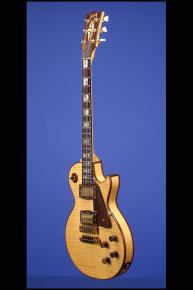The Ultimate Les Paul!
This ultimate Kalamazoo made Les Paul is No. 56 of only seventy-seven produced between 1976 and 1979 (and one of only fifty-nine with the Natural finish). It weighs just 9.90 lbs. and has a nice, fat nut width of just over 1 11/16 inches and a scale length of 24 3/4 inches. Mahogany / maple /mahogany body with highly-figured book-matched maple top, highly-figured book-matched maple back, and sides. Rosewood outer binding and green-and red-stained maple inner bindings. Rosewood control plates on the back. One-piece highly-figured maple neck and three-piece ebony/rosewood/ebony fretboard with 22 frets with twin strips of red-dyed maple around the fingerboard. Inlaid abalone block position markers and side dot markers. Rosewood veneer headstock face with inlaid abalone "Gibson" logo and abalone five-piece split-diamond inlay, with twin strips of red-dyed maple around the headstock and ebony truss-rod cover with "The Les Paul" engraved in red. Original brass nut. Individual Gibson tuners with tulip-shaped mother-of-pearl buttons. Oval mother-of-pearl plate on the back of the headstock: "Reg. No. 56 / 11-13-79". Two "Super Humbucking" pickups (each stamped on the underside "PAT NO 2,737,842") with rosewood surrounds and balanced outputs of 7.59k and 7.47k. Rosewood pickguard. Four controls (two volume, two tone) plus three-way selector switch with rosewood switch tip, the potentiometers are stamped "137 7927" and "137 7928" (CTS July 1979). Handmade rosewood knobs. Wide Schaller style bridge and separate Gibson TP6 tailpiece. All hardware gold-plated. This guitar is in mint condition. Housed in the original Gibson black hardshell case with plush lining (9.00).
"The Les Paul" was one of two new Les Paul models introduced in 1976. "It was a spectacular limited edition notable for its use of fine woods for virtually the entire instrument. Many parts that on a normal electric guitar would be made from plastic were hand-carved from rosewood, including the pickguard, pickup surrounds, backplates, controls and truss-rod cover. Raw bodies and necks of attractive maple, including the back, and an ornate ebony and rosewood fingerboard were produced at Gibson's Kalamazoo factory. Further work on the multiple coloured binding, abalone inlays and handmade wooden parts was continued at the workshop of freelance luthier Dick Schneider, about a mile from the factory in Kalamazoo. Schneider worked on The Les Pauls together with his brother Donnie and Abe Wechter from Gibson...Very few of The Les Pauls were made, and while an unfortunate four-figure misprint in Gibson's own records precludes an exact total, it's most likely that there were well under 100 produced between 1976 and 1979, with most made during the first year...As the limited stocks of Schneider's handmade wooden parts ran out, so normal plastic items were substituted, as well as less ornate binding. Each example of The Les Paul had a numbered oval plate on the back of the headstock" (Tony Bacon, 50 Years of the Gibson Les Paul, p. 72).
According to Dennis Chandler, a former Gibson sales representative, who owns The Les Paul No. 1, a local Cleveland Gibson dealer, Dick Sodja, owner of Sodja Music, was so impressed with the quality, workmanship, and special cosmetic features of this guitar that he ordered one for his store on June 23, 1975. Assuming that No. 1 would go to Les Paul, Dick Sodja expected to receive one of the custom limited production models. In 1976, Les Paul and Chet Atkins received Grammy nominations for their album Chester & Lester. By March of 1976, The Les Paul was close enough to completion that it was loaned to Les Paul for him to play while appearing live on television at the Grammies. After his performance, the guitar was returned to Gibson for final adjustments and cosmetic completion. Gibson luthiers finished the guitar as Les Paul specified and it was fitted with a "Reg. No. 1/3-26-76" mother-of-pearl oval plate on the reverse side of the peghead. Needless to say, Les Paul was extremely eager to receive this very special instrument. However, for some unknown reason, this guitar was never shipped to Les Paul. Instead, the order placed by Dick Sodja at the 1975 NAMM show was filled with the prototype. On March 31, 1976, The Les Paul No. 1 was shipped to Sodja Music. By the time Gibson realized what had happened, it was too late to correct the error. The guitar remained in the inventory of Dick Sodja virtually untouched, until October 10, 1977, when its present owner, Dennis Chandler, purchased it (http://www.dennischandler.com/The_Les_Paul_No__1.html). When Gibson finally did send The Les Paul to Les, it was No. 25.
"The Les Paul is an exquisite guitar, with exceptional attention to detail. Fit and finish are outstanding. The guitar looks and feels as though it has more coats of nitrocellulose lacquer than a typical Les Paul. The tone of the guitar is balanced, percussive, refined and polite, and a little brighter than a typical Les Paul. The guitar featured in this article is 11 lbs. 4 ozs., which is heavy by normal Les Paul standards but light as far as The Les Pauls go, with some rumored to weigh up to 15 lbs. Because of their beauty, price, and weight, many The Les Pauls did not see a lot of playing time. As a result, most available today in the used market are in near mint condition". (Mike Slubowski, The Les Paul: Spectacular Work of Art from the 70's).
The Les Paul’s list price was a staggering $3,000 in 1976, when a Les Paul Custom listed for $739!
Translate:









